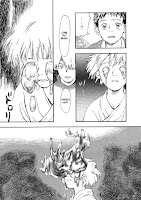


Eureka Seven is an original sci-fi story set in an alternative world, where strange coral formations bulge from the ground and invisible trapar waves that people can 'ride' with strange looking aerial-surfboards fill the air. Sky surfing looks like a ton of fun.
The plot of Eureka Seven is based around that of a thirteen year old mechanic apprentice named Renton and that of a mysterious young girl named Eureka who falls out of the sky (literally) quite early on in the story in an LFO (sky surfing giant robot ). Renton immediately falls head over heals for Eureka and ends up joining her resistance group called Gekko State. Only then to find out she has three kids... It's not really made clear what it is they're resisting or why the military is after them, but there's a lot of action, giant robot fights and laughs along the way.
Eureka Seven has a large cast of characters, the main character obviously being Renton a messy brown haired kid who doesn't know when to stop. Then there is Gekko State, which includes Holland, the swish dressing know-it-all captain. His girlfriend (?) Talho, the pilot of their ship. Eureka and her kids as well as a bunch of other minor characters who have their comical moments. Eureka seveN also characterizes a few antagonists, A young military officer and a strange long haired man who is foreshadowed at the end of the volume.
The art is great, everything is in proportion, the action sequences are well thought out and the character designs are all quite stylish. It's also nice that we get the colour introduction pages in the English copy, where as normally they tend to print them in black and white for us. Violence is kept to a minimum and most of the fighting is done by giant sky surfing robots. Even though the main character is 13, the story and themes are interesting enough that anyone of any age would be able to appreciate it.
Eureka Seven is a unique enjoyable story, full of action, comedy and interesting characterization. Even if your sceptical of giant sky surfing robots, I'd still suggest giving this a try.
![DESUAU : Pop Culture [Anime + Manga + Games] News and Reviews](https://blogger.googleusercontent.com/img/b/R29vZ2xl/AVvXsEjkF58w6aQAUnt83AcZblcUJM6r4qN0zkEij-QCtRsXtVgyU6DhQwEwT8AhihXKUm2zPClERpORX-lVsH-JU3wVPWATGS4ED1jE7DSlwehITSbw0JAq2c5Fn45oDKj2cICSEvudhjyJO1yq/s1600-r/titletop6.png)

























